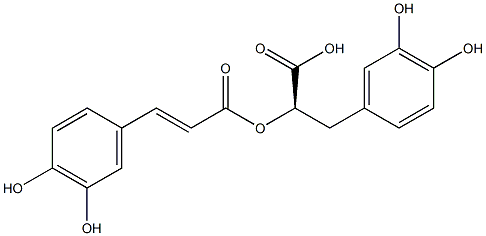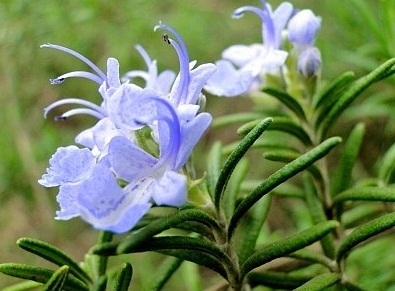

Rosmarinic acid
| Price | USD1.00 |
| Packge | 1kg |
- Min. Order:1g
- Supply Ability:100KG
- Time:2019-07-06
Product Details
- Product NameRosmarinic acid
- CAS No.20283-92-5
- EINECS No.606-487-1
- MFC18H16O8
- MW360.31
- Appearancepowderwhite to faintly beige
- Melting point 171-175 °C (lit.)
- density 1.33
- storage temp. 2-8°C
- Boiling point 694.7±55.0 °C(Predicted)
| Rosmarinic acid Basic information |
| Product Name: | Rosmarinic acid |
| Synonyms: | 3-(3,4-DIHYDROXYPHENYL)ACRYLIC ACID-1-CARBOXY-2-(3,4-DIHYDROXYPHENYL)ETHYL ESTER;3,4-DIHYDROXYCINNAMIC ACID (R)-1-CARBOXY-2-(3,4-DIHYDROXYPHENYL)ETHYL ESTER;[4ar-(4aa,9b,10a,10ab)]-1,3,4,9,10,10a-hexahydro-5,6,9-trihydroxy-1,1-dimethyl-7-(1-methylethyl)-2h-10,4a-(epoxymethano)phenanthren-12-one;ROSMARINATE;(r)-o-(3,4-dihydroxycinnamoyl)-3-(3,4-dihydroxyphenyl)lactic acid;(R)-2-(3,4-DIHYDROXYCINNAMOYLOXY)-3-(3,4-DIHYDROXYPHENYL)LACTIC ACID;(R)-ALPHA-[[3-(3,4-DIHYDROXYPHENYL)-1-OXO-2E-PROPENYL]OXY]-3,4-DIHYDROXY-BENZENEPROPANOIC ACID;[R-(+)]-ALPHA-[[3-(3,4-DIHYDROXYPHENYL)-1-OXO-2-PROPENYL]OXY]-3,4-DIHYDROXYBENZENEPROPANOIC ACID |
| CAS: | 20283-92-5 |
| MF: | C18H16O8 |
| MW: | 360.31 |
| EINECS: | 1308068-626-2 |
| Product Categories: | Plant Oils, Toxins, Phenolic Acids & Derivatives;Prostanoid receptor and related;Plant extracts;chemical reagent;pharmaceutical intermediate;phytochemical;reference standards from Chinese medicinal herbs (TCM).;standardized herbal extract;Inhibitors;Lignans |
| Mol File: | 20283-92-5.mol |
 |
|
| Rosmarinic acid Chemical Properties |
| Melting point | 171-175 °C(lit.) |
| density | 1.33 |
| storage temp. | Store at RT |
| solubility | H2O: soluble1mg/mL, clear, colorless |
| color | white to faintly beige |
| InChIKey | DOUMFZQKYFQNTF-WUTVXBCWSA-N |
| CAS DataBase Reference | 20283-92-5(CAS DataBase Reference) |
| Safety Information |
| Hazard Codes | T |
| Risk Statements | 25 |
| Safety Statements | 45 |
| WGK Germany | 3 |
| RTECS | GD8990000 |
| F | 10-23 |
| HS Code | 29189900 |
| MSDS Information |
| Provider | Language |
|---|---|
| SigmaAldrich | English |
| Rosmarinic acid Usage And Synthesis |
| Uses | 1. Rosmarinic acid is an ester of caffeic acid and 3,4-dihydroxyphenyllactic acid. It is commonly found in species of the Boraginaceae and the subfamily Nepetoideae of the Lamiaceae. However, it is also found in species of other higher plant families and in some fern and hornwort species. Rosmarinic acid has a number of interesting biological activities, e.g. antiviral, antibacterial, antiinflammatory and antioxidant. The presence of rosmarinic acid in medicinal plants, herbs and spices has beneficial and health promoting effects. In plants, rosmarinic acid is supposed to act as a preformed constitutively accumulated defence compound.[sciencedirect] 2. Rosmarinic acid (RA) is one example of a naturally occurring phenolic compound in plants. RA is especially high in Salvia officinalis (garden sage). As an antioxidant, RA possesses both health benefits, and is useful as a food additive to keep foods fresh.Recently, Bakota et al. successfully prepared an extract of Salvia officinalis at three times the levels from sage leaves alone.[thermofisher] 3. Rosmarinic Acid is a phenylpropanoid isolated from Labiatae herbs. The compound exhibits antiinflammatory activity and inhibits the proliferation of murine mesangial cells. Rosmarinic Acid has been shown to dose dependently inhibit migration, adhesion, and invasion of Ls174-T human colon carcinoma cells. Rosmarinic Acid has been documented to increase the melanin content in B16 melanoma cells through activation of protein kinase A. In the same study rosmarinic acid induced the phosphorylation of CRE-binding protein (CREB) and activated cAMP response element (CRE). In the classical complement pathway Rosmarinic Acid inhibited C3-convertase. It also has shown to be an activator of GPR35.[Santa Cruz] 4. Rosmarinic acid is a naturally-occurring phenolic compound with antioxidant and anti-inflammatory properties. This compound inhibits lipid peroxidation of rat liver microsomes by 90% at a concentration of 25 µg/ml.Rosmarinic acid suppresses endotoxin-induced activation of complement and concomitant formation of prostacyclin.Formation of 5-HETE and LTB from human PMNL is inhibited by rosmarinic acid at concentrations of 10-5 to 10-3 M. [caymanchem] |
| Rosmarinus officinalis | Rosmarinus officinalis belongs to genus Rosmarinus and family Lamiaceae. This plant is a small evergreen shrub, about 1 meter high, and young shoots are 4-sided and closely arranged, with dense hairs; leaves opposite, sessile, leathery, linear, with surface dark green and smooth, and leaf back gray and finely hairy; Flowers bisexual, paired grown on short stalk, axillary, calyx bell-shaped, two lips, with upper lip entire and lower lip two-lobed; corolla 3 times longer than calyx, 2 lips, with upper lip furrow into two-lobs and lower lip concavely tri-lobed to the middle; 2 fertile stamens that extend out of the flower; flowers pale blue color, sometimes pink or white; flowers in spring, with a rich aroma. Rosmarinus officinalis is native to the North Africa and was transported to China after Zhang Qian went to the Western Regions, and it was a traditional commodity among Roman Empire, the Eastern Roman Empire and China, that’s why Chinese also called it "the Daqin aroma." This plant is both a medicinal and edible herb with an oil body, and it is available for viewing and extracting aroma, and the fresh twigs and buds of rosemary can be used also to extract aromatic oils. This aromatic oil is used in deployment of food flavor and seasoners and the production of sauce. As a food seasoner, Rosmarinus officinalis is seldom used in Chinese food but mainly in western food, it is quite common in Europe, and is still a very popular cooking spice in Europe so far.  Figure 1 The Photo of Rosmarinus officinalis Rosmarinus officinalis is a historic spice plant, which is native to the Mediterranean coast. It was first introduced to China in 1981 by the Chinese Academy of Sciences and with the successful cultivation, and now has been grown in Yunnan, Hunan, Sichuan, Guizhou, Guangxi and other places. Rosmarinus officinalis is a valuable natural aromatic plant, and in the growing season it will emit a kind of fragrance smell with the function of purifying heart and refreshing spirits. Its stems, leaves and flowers have a pleasant scent, and aromatic oil that extracted from flowers and twigs can be used to deploy air cleaners, perfumes, soaps and other cosmetics. The most famous lotion is made with rosemary, and it can be used in beverages, skin care oils, hair tonic, washing paste. As a medicine, it can be used in treatment of neurological disorders and in ointment production to treat headache and rheumatism. In recent years, it has also been found to be an ideal natural preservative. It also can be planted or potted as ornamental plants. Rosmarinus officinalis is a versatile commercial crop, from which antioxidants and rosemary essential oils and pharmaceutical intermediates can be extracted. Antioxidants are powdery substance that extracted from Rosmarinus officinalis; with the main ingredients with antioxidant function are phenolic, acids, and flavonoids and so on. rosemary essence oil is a kind of liquid oil consisting of 30 kinds of volatile components. The powdery extract substance rosmarinic acid from Rosmarinus officinalis has an efficient, non-toxic antioxidant effect and can be widely used in food, functional foods, spices and condiments and household chemicals industries. |
| Antimicrobial activity | Rosmarinic acid has a broad-spectrum anti-microbial activity against bacteria and fungi. Rosmarinic acid can significantly inhibit Bacillus subtilis, Micrococcus luteus, Escherichia coli, Staphylococcus aureus and Rhizoctonia and other bacteria. Neusa found that rosmarinic acid could inhibit the growth of Streptococcus mutans and Caries streptococci and the formation of biological membrane, reducing their glucose transferase activity, which indicating that rosmarinic acid can be used for oral disease prevention and treatment. Studies in mechanism of antibacterial activity of rosmarinic acid showed: on the one hand, rosmarinic acid can increase the permeability of the bacterial cell membrane, resulting in a lot of leakage of carbohydrates and protein, affecting the normal metabolism of bacteria; on the other hand, it can also affect protein metabolism of bacteria, and also inhibit Taq DNA polymerase. Guo Daosen studied the inhibition effects of rosmarinic acid on mycelial growth and spore germination of different plant pathogenic fungi, and found that rosmarinic acid had stronger inhibition on mycelial growth of tomato Botrytis cinerea, mango gray leaf spot pathogen, citrus Penicillium and pear Alternaria panax, with the strongest inhibition in spore germination of pear Alternaria panax. Rosmarinic acid has antibacterial activity on both the Gram-negative bacteria E. coli and the Gram-positive bacteria Staphylococcus aureus, but the sensitivity of S. aureus to rosmarinic acid is significantly higher than that of E. coli. The results also show that rosmarinic acid can significantly increase the permeability of the bacterial cell membrane, accelerate the leakage of carbohydrate and protein, and cause disorder of the cell metabolism. Rosmarinic acid can affect protein metabolism of bacteria. By comparing the total protein in Staphylococcus aureus before and after the treatment of rosmarinic acid, it is known that treatment of rosmarinic acid promotes degradation of certain proteins in bacterial metabolism, or promotes the synthesis of certain proteins in short term. As for which specific protein is affected by rosmarinic acid, further identification is still needed. Through the experimental results of interaction between rosmarinic acid and plasmid DNA, we know that rosmarinic acid does not interact with DNA, whereby it can be speculated that rosmarinic acid can not bind with the primers in the polymerase chain reaction system, thus rosmarinic acid inhibits polymerization chain reaction because this compound inhibits the binding activity of the DNA polymerase, thereby inhibiting the replication of DNA. In summary, rosmarinic acid has a certain influence on the permeability of cell membrane, protein metabolism and DNA replication in bacteria, and thus plays its anti-bacteria effect. The above information is edited by the Chemicalbook of Cheng Jingmin. |
| Chemical Properties | White to off-white powder |
| Uses | Rosmarinic Acid is a phenolic compound with antioxidant and anti-inflammatory activity. Rosmarinic Acid has been shown to inhibit againts peroxidative damage to biomembranes. Rosmarinic Acid also supp resses endotoxin-induced activation of complement and concomitant prostacyclin biosynthesis. |
| Uses | An activator of GPR35. |
| Definition | ChEBI: A stereoisomer of rosmarinic acid having (R)-configuration. |
| Uses | Rosmarinic acid is a naturally-occurring phenolic compound with antioxidant and anti-inflammatory properties. This compound inhibits lipid peroxidation of rat liver microsomes by 90% at a concentration of 25 μg/ml. Rosmarinic acid suppresses endotoxin-induced activation of complement and concomitant formation of prostacyclin. Formation of 5-HETE and LTB4 from human PMNL is inhibited by rosmarinic acid at concentrations of 10-5 to 10-3 M. |
| Biological Activity | Anti-inflammatory, cytostatic and antiviral. |
Company Profile Introduction
Henan CoreyChem Co., Ltd, based on the original Zhengzhou Cote Chemical Research Institute, be brave in absorbing highly educated talents & overseas returnees; actively responded to Zhengzhou City High-tech Zone Government’s Special Care Policy, reorganized and founded in National University of Science and Technology Park, which is a high-tech, stock enterprise of high-end chemical Custom synthesis;The park was created by the People's Government of Henan Province, and proved by Ministry of Education and the National Science & Technology, taking the construction mode of "many college a park, and common development", mainly depends on Zhengzhou University and Henan University’s scientific research and talent advantage to set up Universities, scientific research institute and enterprise scientific research achievements transformation platform, to make high-tech enterprises incubate, is the new high-tech talent gathering base, high and new technology industry enterprise radiation base, colleges and universities technological innovation base.
Henan Coreychem Co., Ltd, facing global High-tech pharmaceutical raw materials, high complex new type intermediates, fine chemicals custom synthesis, scale-up production and Rare chemicals trade. Corey have well-equipped machine, strong technical force and considerate marketing team service. We also have rich experience advantage in basic research, small scale process development, scale-up, industrial technology development & production and cost control.
Recommended supplier
-
VIP1年
- Sami Sabinsa Group Limited (formerly Sami Labs Limited)
- Rosmarinic acid 20283-92-5 98%
- Inquiry
- 2024-02-29
-
VIP1年
- Globela Industry Pvt Ltd
- Rosmarinic acid 98%
- Inquiry
- 2024-02-22
-
VIP1年
- Amuna Pharmaceuticals LLP
- 20283-92-5 99%
- Inquiry
- 2024-01-23
-
VIP1年
- Phytotech Extract Pvt Ltd
- 20283-92-5 Rosmarinic acid 99%
- Inquiry
- 2024-01-12
- Since:2014-12-17
- Address: No.967,15th Floor,Unit 7, Building 1, No.70 of DianChang Road, High-tech Development Zone, Zhengzho
INQUIRY
